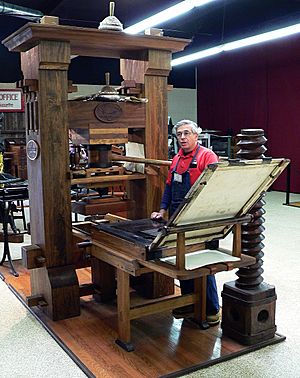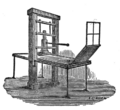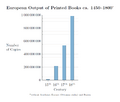Printing press facts for kids
The printing press is a machine for printing. It makes many copies of identical pages. The printing press today is used to print books and newspapers. It had a great influence on society, especially western society.
Woodcut printing has been done for several centuries. That was whole pages cut into wood, words and pictures. In the 15th century Johannes Gutenberg improved the process. He used separate alloy letters screwed into a frame. This way a large set of letters could make almost any page for printing. This process was called typesetting. Each letter was in a block of metal, fixed in a frame. He could then move paper and ink over it, much like a stamp. This method was called letterpress. The letters would leave ink on the paper in the shape of the letters, creating text or illustrations.
Bigger and much faster presses were invented in the industrial revolution. The main improvements were made in the 19th century. Two ideas altered the design of the printing press entirely. First was the use of steam power to run the machinery. Second was the replacement of the printing flatbed with the rotary motion of cylinders. Both were done by the German printer Friedrich Koenig between 1802 and 1818. Having moved to London in 1804, Koenig got financial support for his project in 1807. In 1810, Koenig patented a steam press "much like a hand press connected to a steam engine".
Soon other inventions were added, such as the making of cheaper paper by using wood pulp instead of rags. Later in the 19th century came machines which speeded up typesetting, which was previously done by hand, letter by letter. A machine for hot metal typesetting was designed by Linotype Inc. It turned molten lead into type ready for printing.
Many further developments in printing happened in the 20th century. Today printing presses are controlled by special-purpose computers, and the material to be printed is prepared on computers. As a consequence of these inventions, the cost of printing has fallen significantly compared to other commodities. Now the price of a book or magazine is less determined by its production, and more by other factors, such as marketing.
Images for kids
-
Medieval university class (1350s)
-
Early modern wine press. Such screw presses were applied in Europe to a wide range of uses and provided Gutenberg with the model for his printing press.
-
Movable type sorted in a letter case and loaded in a composing stick on top
-
A paper codex of the acclaimed 42-line Bible, Gutenberg's major work
-
This woodcut from 1568 shows the left printer removing a page from the press while the one at right inks the text-blocks. Such a duo could reach 14,000 hand movements per working day, printing ca. 3,600 pages in the process.
-
"Modern Book Printing" sculpture, commemorating Gutenberg's invention on the occasion of the 2006 World Cup in Germany
-
Koenig's 1814 steam-powered printing press
-
Stanhope press from 1842
See also
 In Spanish: Imprenta para niños
In Spanish: Imprenta para niños



















